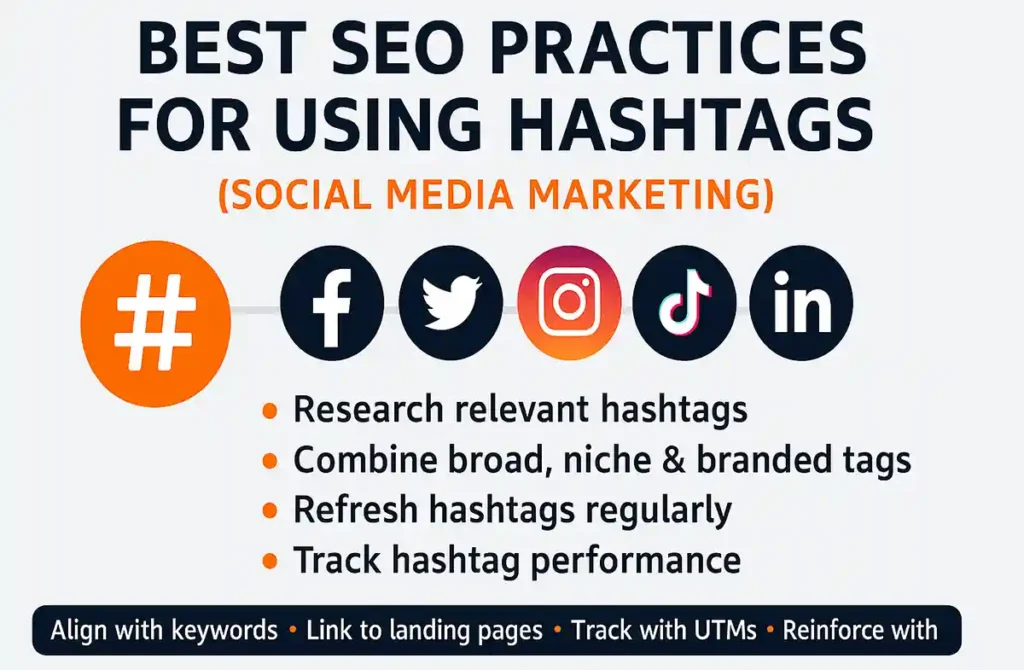A Complete Guide to Facebook, Twitter, Instagram, Pinterest, TikTok and LinkedIn
Hashtags are one of the most misunderstood tools in digital marketing. Many businesses either overuse them, ignore them, or chase vanity hashtags that bring in no real customers. Yet, when used correctly, hashtags serve as search signals. They act as real-time keywords, guiding social algorithms and users towards your content.
For business owners, this means that hashtags are not just about visibility on social platforms; they also directly connect to SEO. They strengthen your brand footprint, align with the keywords you optimise onsite, and help build consistent signals across the web.
This guide takes you through everything you need to know: how hashtags work, how to use them on the leading platforms (Facebook, Twitter, Instagram, Pinterest, TikTok and LinkedIn), and how to align them with SEO best practice so that your social content marketing and website work hand-in-hand.
This guide is detailed. Use the quick links below to jump straight to the sections that matter most for your business.
Quick jump to sections
What Are Hashtags and Why Do They Matter for SEO?
A hashtag is simply a keyword or phrase with a # symbol. On the surface, it looks simple. In practice, it serves two powerful functions:
- Platform categorisation – social networks use hashtags to sort and surface relevant content.
- SEO signalling – hashtags operate like live keywords, creating semantic links between your social activity and your website’s keyword strategy.
Think of hashtags as shortcuts to discoverability. On Instagram or TikTok, they get your content into streams where people are already looking. On LinkedIn and Twitter, they anchor you into industry conversations. For Google, they create reinforcing signals that your brand owns specific topics, services, and locations.
Without them, your posts risk staying invisible beyond your current followers. With them, you create pathways for new audiences and potential customers to find you.
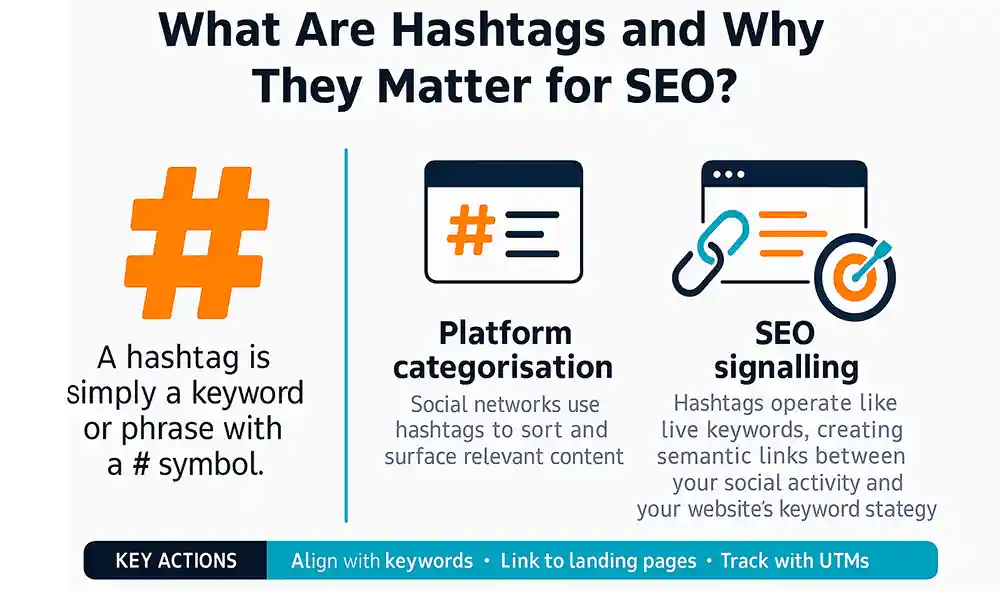
General Best Practices for SEO-Friendly Hashtags
Hashtags work best when they’re planned, relevant, and aligned with your wider SEO strategy. Too often, they’re treated as an afterthought, added at the end of a post without much thought about audience intent, keyword alignment, or long-term impact. But hashtags are essentially the social media equivalent of keywords. They guide algorithms in the same way keywords guide search engines: by signalling what your content is about and who it should reach. When you approach them with the same discipline as keyword research, mapping them to services, locations, campaigns, and audience segments, they stop being a scattergun tactic and start becoming a measurable driver of reach, engagement, and even search visibility.
Key Principles
- Relevance first – Only use hashtags that clearly connect to your content. Popular hashtags that don’t align with your brand can dilute it.
- Mix categories – Use a blend of broad, niche, branded, and location hashtags. This widens the reach while maintaining focus.
- Platform-specific ranges – Each platform has an optimal count. Exceeding it looks spammy and often reduces visibility.
- Refresh quarterly – Hashtag popularity changes fast. Review lists and replace low performers.
- Avoid banned/spammy hashtags – Instagram and TikTok in particular penalise irrelevant or banned tags.
Optimal ranges per platform
| Platform | Best Range | Notes |
| 1–2 | Best for campaigns or local events | |
| Twitter (X) | 1–2 | Central to trends and live chats |
| 3–5 in captions, up to 30 in comments | Prioritise relevance | |
| 2–5 | Functions as long-term keywords | |
| TikTok | 3–6 | Combine trending + niche |
| 3–5 | Professional, industry-focused |
Action Steps
- Build tiered lists of hashtags: broad, niche, branded, location-specific, and campaign-related.
- Rotate sets based on post type (e.g., product post vs. thought leadership).
- Check alignment with your website keywords and content themes.
- Save lists in a shared document or scheduling tool for easy access.
Platform-by-Platform Hashtag Strategy

Hashtags are less central on Facebook than on other platforms, but they still help with discovery during campaigns and events. From an SEO and branding perspective, the value is subtle but still real. Facebook posts often surface in Google’s search results, especially public event pages and community posts, which means a well-placed hashtag can extend your visibility outside of Facebook itself. For local businesses, a single campaign hashtag on Facebook can create brand consistency across ads, groups, and customer shares, tying together both online visibility and community presence.
Best practice:
- Use 1–2 per post.
- Focus on branded or campaign-specific hashtags (#ShopLocalDorset).
- Add local hashtags for visibility (#PooleEvents, #BournemouthMarkets).
- Keep posts clean and professional; unlike Instagram, Facebook audiences engage more with direct calls-to-action than with long hashtag lists.
X (Twitter)

X thrives on hashtags. Using hashtags on X drives trends, live events, and topic discovery. The real benefit for businesses isn’t just reach in the moment, it’s the visibility those conversations carry into wider search. Tweets are indexed quickly by Google, so a hashtag on X used in the proper context can extend brand authority beyond the platform itself. For SMEs, participating in an industry hashtag or national event discussion is like stepping onto a public stage where your expertise can be showcased, quoted, and shared. Done right, it builds both immediate engagement and long-tail SEO signals.
Best practice:
- Stick to 1–2 hashtags per tweet.
- Use official hashtags for national conversations or events (#Budget2025, #SmallBusinessUK).
- Combine one industry tag with one geo tag (#DigitalMarketing, #BournemouthBusiness).
- Monitor trending hashtags daily — join when relevant.

Instagram remains hashtag-heavy, though the platform’s focus has shifted from volume to relevance. For businesses, this is good news. Instead of spamming 30 generic hashtags, a handful of carefully chosen ones can align directly with your brand positioning and SEO goals. Instagram hashtags also feed into Google image search, meaning your posts can surface well beyond the app if they’re anchored to the right keywords. When you combine niche, branded, and location-based tags, you’re not only reaching the right audience in-app, you’re also cementing your topical authority and increasing your chances of appearing in Google’s image results.
Best practice:
- Add 3–5 hashtags in captions.
- If using larger sets (10–30), place them in the first comment.
- Mix broad, niche, and geo hashtags (#DorsetFitness, #BournemouthPT).
- Highlight Instagram-specific placement (caption vs comment).
- Track with Instagram Insights to refine.
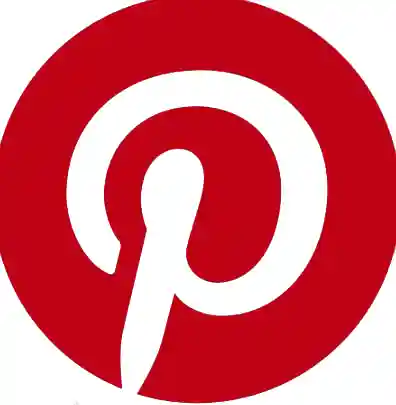
On Pinterest, hashtags function much like long-term SEO keywords. Pins can continue to surface in searches months after publication, making them a rare social asset with genuine staying power. From a brand perspective, this means the effort you put into the right hashtags today can continue to deliver impressions, clicks, and saves well into the future. For SEO, the benefit is twofold: not only do Pinterest boards and pins often rank in Google’s results, but Pinterest hashtags serve as indexing signals that extend your brand’s semantic reach well beyond the platform. It’s one of the few platforms where social activity directly supports both immediate discovery and ongoing organic search visibility.
Best practice:
- Use 2–5 hashtags per pin description.
- Focus on topic and long-tail hashtags (#WeddingPlanningUK, #HomeDesignIdeas).
- Mix evergreen + seasonal hashtags.
- Think of Pinterest hashtags as mini search queries.
TikTok
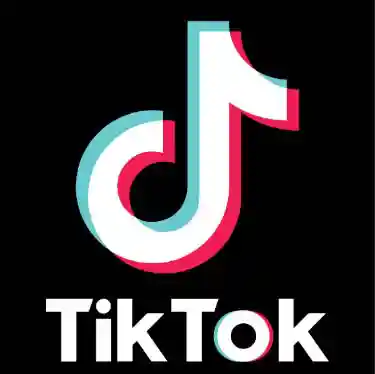
Hashtags influence distribution on the For You Page (FYP). Trends move quickly, so agility matters. The real opportunity for businesses is that TikTok hashtags don’t just drive short bursts of attention; they also shape how your brand gets categorised by the algorithm. When you pair trending tags with niche or local ones, you’re effectively telling TikTok, “this content belongs in these conversations and locations.” That’s brand positioning at scale. From an SEO perspective, TikTok videos are now being indexed by Google, so the hashtags you use can impact whether your clips appear in search results outside the app. For SMEs, this means that hashtags serve as both an instant engagement driver and a longer-term visibility play.
Best practice:
- Use 3–6 hashtags.
- Mix trending hashtags (#fyp) with niche and geo tags (#DorsetCafe, #MarketingTips2025).
- Track weekly trends and adapt fast.
- Keep hashtags relevant to avoid poor engagement.

Professional and authority-driven, hashtags on LinkedIn build thought leadership. They position your content within industry conversations where decision-makers are actively searching for insights. The brand benefit is credibility: using the right mix of industry, location, and niche hashtags signals expertise and places your business alongside established voices. From an SEO standpoint, LinkedIn posts and articles are highly visible in Google search, so well-chosen hashtags signal relevance in Google’s index, giving your content a second life outside LinkedIn itself.. For SMEs, this is a low-cost way to appear in both professional feeds and search results, reinforcing your authority and increasing the chances of being discovered by the right audience at the right time.
Best practice:
- Use 3–5 hashtags per post.
- Stick to professional/industry hashtags (#DigitalMarketingUK, #SEOStrategy).
- Add geo-business tags (#BournemouthBusiness).
- Branded hashtags work well for campaigns.
Types of Hashtags Every Business Should Use
Every strong hashtag strategy covers six categories:
- Branded – Unique to your business (#DigitalHypeSEO).
- Campaign – Event or promotion driven (#ShopLocalDorset).
- Community – Connecting to wider groups (#WomenInBusiness).
- Location – Geo relevance for local SEO (#PooleRestaurants).
- Niche – Specific, high-intent hashtags (#EcommerceSEO).
- Trending – Temporary boosts when aligned.
***The most effective posts combine one to two elements from each group. ***
How to Research the Best Hashtags
Hashtag research should align with keyword research for SEO.
Methods:
- Competitor analysis – Identify hashtags used by rivals; find gaps.
- Native search – Use Instagram, LinkedIn, TikTok search to discover related hashtags.
- Tools – Sistrix, Inflact, All Hashtag, Ahrefs, Canva, Keyword Tool.
- Frequency balance – Choose a mix: high volume for exposure, mid-to-low volume for visibility.
- Refresh regularly – Replace underperforming hashtags every quarter.
SEO integration:
- Map hashtags to your content clusters (e.g. website blog on “SEO Services Bournemouth” → #BournemouthSEO).
- Ensure that hashtags reinforce your target keywords and entities.
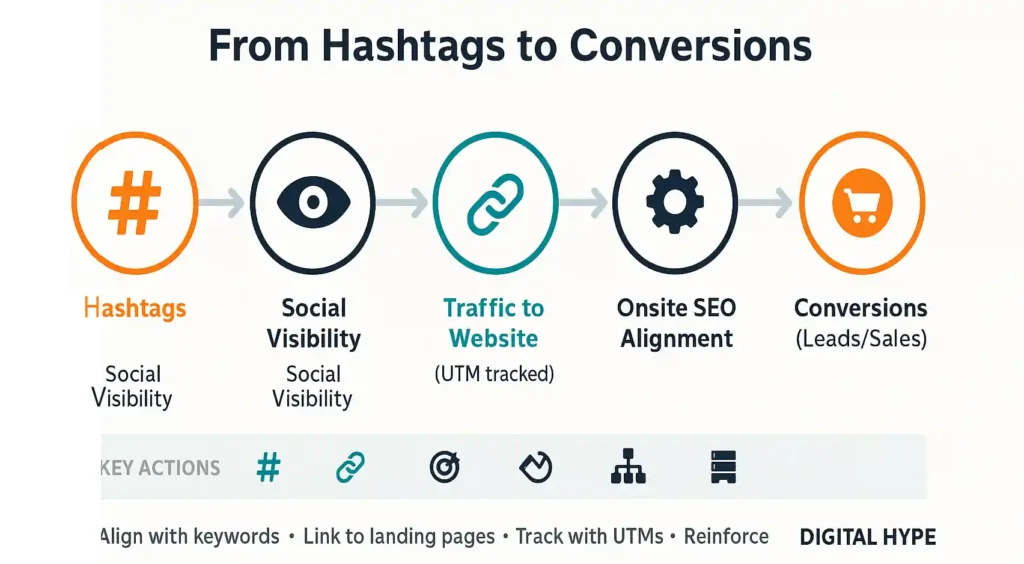
Tracking & Measuring Hashtag Performance
You can’t improve what you don’t measure. Hashtags need tracking to prove ROI, just like any other element of your digital marketing. It’s not enough to know you’re getting likes or reach — the real question is whether those hashtags are driving meaningful traffic, enquiries, or sales. By monitoring impressions, engagement, and conversions, you can determine which tags are effective and which are merely occupying space. This is where a structured approach matters. The same way an experienced social media agency manages campaigns with clear reporting, your hashtag strategy should be built on evidence, not guesswork. Done right, measurement turns hashtags from a vanity tactic into a reliable growth lever.
Key metrics:
- Reach and impressions.
- Engagement (likes, comments, shares, clicks).
- Follower growth.
- Website traffic and conversions (via UTM tags).
Tools:
- Built-in analytics (Instagram Insights, X Analytics, LinkedIn Analytics, TikTok Pro, Pinterest Analytics, Facebook Insights).
- Third-party platforms like Sprout Social, Hootsuite.
SEO alignment:
- Use UTMs to track which hashtags drive traffic and leads to your website.
- Compare top-performing hashtags against your keyword performance in Search Console.
Advanced SEO Integration with Hashtags
Here’s where most guides stop — but this is what turns hashtags into SEO assets.
- Align hashtags with onsite keywords – Every campaign hashtag should map to an onsite page or blog.
- Build landing pages for recurring hashtags – E.g. a #ShopLocalDorset page optimised around the campaign theme.
- Entity optimisation – Use hashtags tied to known entities (#GoogleAds, #SEO, #Ecommerce).
- Local SEO synergy – Match local hashtags with your Google Business Profile and local citations.
- UGC integration – Feature hashtag-driven user content on your site (fresh content = SEO benefit).
- Schema markup – Embed campaign hashtags into Event or CreativeWork schema to connect onsite activity with offsite social buzz.
- Backlink opportunities – Hashtags that generate traction often lead to shares and media mentions; track these as part of your link-building efforts.
Hashtags vs Keywords: What’s the Difference?
Business owners often confuse hashtags with SEO keywords. They’re closely related but work in different ways.
| Aspect | Hashtags (Social SEO) | Keywords (Traditional SEO) |
| Format | #word or #phrase | Plain text words or phrases |
| Where Used | Social media captions, comments, bios, stories | Website content, meta tags, titles, blogs |
| Purpose | Sort content within social platforms | Rank content in Google & search engines |
| Speed | Immediate visibility in hashtag feeds | Takes weeks/months to rank |
| Discovery | Helps users find posts via platform search | Helps users find pages via Google/Bing |
| Longevity | Often short-term (hours to weeks) | Long-term visibility (months to years) |
| Best Use | Awareness, community, campaign engagement | Evergreen traffic, authority, lead gen |
Common Hashtag Mistakes to Avoid
- Copy-pasting the same list on every post.
- Using irrelevant hashtags for reach.
- Stuffing 20+ hashtags on platforms that favour fewer.
- Not updating hashtag lists.
- Using banned hashtags.
- Forcing irrelevant trends.
Hashtag Do’s and Don’ts
A quick reference guide for business owners to maintain effective and professional hashtag use.
Do’s:
- ✅ Align hashtags with your content and keywords.
- ✅ Use a mix of broad, niche, location, branded and campaign tags.
- ✅ Keep within optimal platform ranges (see table above).
- ✅ Refresh hashtag lists every quarter.
- ✅ Track hashtag performance and replace poor performers.
- ✅ Test placement (caption vs first comment) to see what works best.
- ✅ Use hashtags for UGC campaigns and encourage followers to post.
Don’ts:
- ❌ Spam 20+ hashtags on every platform.
- ❌ Use irrelevant trending hashtags for “exposure.”
- ❌ Copy-paste the same list on every post.
- ❌ Forget to check if a hashtag is banned or inactive.
- ❌ Use hashtags with no connection to your audience or goals.
- ❌ Assume what worked last year still works today.
Business Owner FAQs: Hashtags, SEO & Social Media Marketing
Do I need different hashtags for every post, or can I reuse the same ones?
It’s best to mix things up. Repeating a few core hashtags keeps your brand consistent, but adding new, relevant ones for each post helps you reach fresh audiences. Think of it like rotating keywords in your blog posts.
How do I avoid looking spammy when I use hashtags?
Keep them relevant and don’t overload the post. For example, a local bakery might use #BournemouthBakery, #FreshBread, and #DorsetFoodie, rather than a long string of generic tags like #love #happy #instagood. Relevance always beats volume.
Should I research competitors’ hashtags?
Yes — but don’t copy them word for word. Look at which hashtags competitors are using and note which ones seem to get good engagement. Then adapt the list to fit your own services, location, or customer focus.
Do hashtags work the same way for paid ads as they do for organic posts?
Not exactly. In paid ads, targeting is driven by audience settings rather than hashtags. But adding them in ads can still boost discoverability if people share or comment on your campaign. Treat them as a bonus, not the main targeting tool.
Can hashtags help me build a community around my business?
Definitely. A branded hashtag gives customers and followers a place to share their own photos, reviews, or experiences. Over time, it becomes a hub of user-generated content that strengthens loyalty and word-of-mouth marketing.
How often should I update my hashtag lists?
At least every three months. Trends change, and a hashtag that worked last season may not get the same traction now. Set a reminder to review performance and swap out underperforming tags.
Is it better to use big popular hashtags or smaller niche ones?
A mix is ideal. Popular hashtags get more eyes, but also more competition. Niche hashtags may have fewer posts, but they’re more targeted, meaning the people who see them are more likely to be your potential customers.
Can hashtags really help my website traffic, or are they just for social?
They can definitely help your website traffic when used strategically. For example, if you post with a campaign hashtag that links to a landing page, and track it with UTM links, you can see exactly how many visitors came from that hashtag campaign.
Quick Reference: Best Practice Hashtags by Platform
| Platform | Optimal Hashtags | Best Use | Example |
| 1–2 | Campaigns, events, community | #ShopLocalDorset #PooleEvents | |
| Twitter (X) | 1–2 | Trends, live chats, industry | #SmallBusinessUK #Budget2025 |
| 3–5 (caption), up to 30 (comment) | Discovery, niche targeting | #DorsetFitness #BournemouthPT | |
| 2–5 | Long-term search categorisation | #WeddingPlanningUK #HomeDesignIdeas | |
| TikTok | 3–6 | Trending + niche discovery | #FYP #DorsetCafe |
| 3–5 | Professional, industry, geo | #DigitalMarketingUK #BournemouthBusiness |
Bringing Hashtags Into Your Social Media Marketing Strategy
Hashtags are more than a decorative extra on social posts; they are practical tools that shape how your brand is discovered, talked about, and remembered. When they’re chosen with intent, hashtags connect your content with the right conversations, amplify your campaigns, and give your brand a consistent presence across multiple platforms.
Used strategically, they don’t just boost likes or visibility in the moment. They build community, support long-term brand awareness, and ensure your posts work harder as part of a joined-up social media marketing approach. The businesses that treat hashtags as part of their wider strategy, not as an afterthought, will be the ones that consistently show up, get shared, and stay at the forefront of their audience’s minds.
Take Your Social Media Marketing Further
Hashtags are just the start of building visibility. At Digital Hype, we help SMEs, local businesses, and national brands connect the dots — from social media optimisation through to SEO and conversion-driven campaigns. If you want to turn your social activity into measurable growth, let’s talk.

